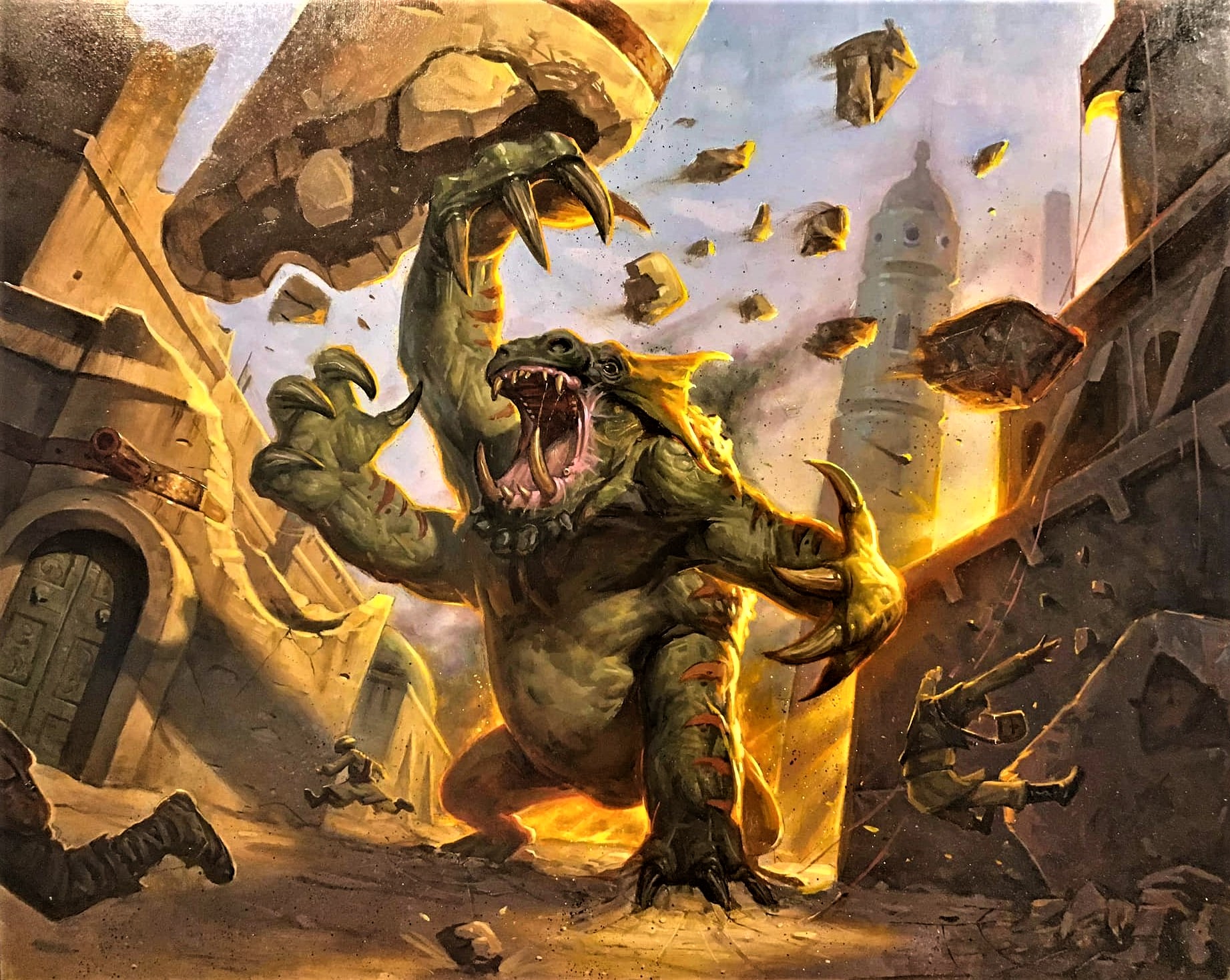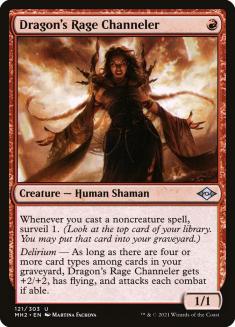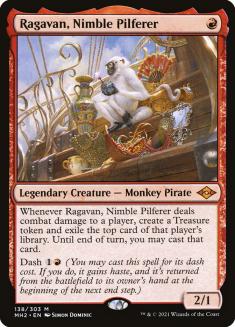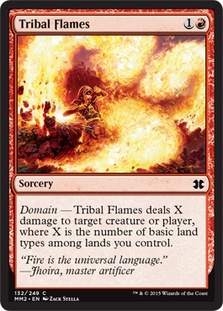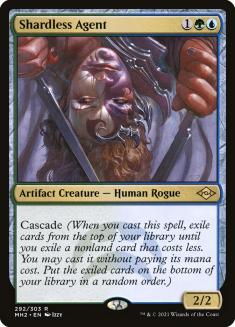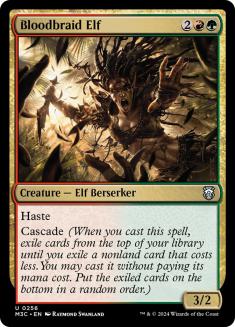Hello, and welcome to this edition of Sullivan’s Satchel. With Modern Horizons 2 in full swing on Magic Online (MTGO) I have once again dived head-first into Modern, primarily with Izzet Prowess (which I wrote about last week). I have yet to experiment with Burn, but that’s on the agenda if and when the price of Ragavan comes down a little bit and I can experiment with one copy (likely making the deck much worse in the process).
Dragon’s Rage Channeler has exceeded expectations and then some, and from what I can gather online, it’s even showing up in Legacy. Wouldn’t surprise me if those two cards ended up being a 2021 analog to Shadowmage Infiltrator and Psychatog, with the rare getting all the hype and secondary market juice while an uncommon with the same mana cost ended up being the real prize.
As far as the set’s impact on the format as a whole, I’ve really enjoyed it. Urza’s Saga and the Food stuff seems very pushed, but those cards don’t carry a ton of weight in combo matchups or other games played on a short timeline (like some of the cascade decks, which I play against a lot) and the format is hostile enough to that kind of card and deck generally that it’s subsidization in the right direction. Urza’s Saga is one of the most open-ended build-arounds I’ve ever seen, working as both a value engine and a toolbox, sometimes both roles in the same deck.
The reprints are doing work; I have encountered Counterspell, Vindicate, Fire // Ice, and even Flame Rift with some regularity, all of which are powerful-but-ultimately-tolerable additions. Unlike the first go-around, when Hogaak, Arisen Necropolis was plainly out of bounds and players just had to wait for the “real”, post-ban format to take shape, this seems legitimate and possibly sustainable so far. No small task.
With that, the questions. As always, you can send in yours to [email protected] or DM on Twitter @BasicMountain. I answer the questions as they come in, more or less, and most weeks one is selected as Question of the Week, with its author receiving $25 in SCG credit.
From Hagen Kirk:
Sort of. The design was pretty much what it was when I started working on the file, but I was an advocate for a much more pushed version, which is what I believe ultimately went to print. I thought it was a good bet (not without risk) to shoot high with for a number of reasons.
- The bar for a one-drop with one toughness and a hit trigger to get into a format like Modern is extremely high. Stuff like that doesn’t show up, as a rule.
- It’s fun. I believe in the gameplay, and while all powerful cards risk repetition in a broad sense (they show up a lot, which is repetitive), it plays very differently from game to game and matchup to matchup, which dampens that risk a considerable amount.
- Even if it came in much higher than anticipated, the format has a million strong backstops against that sort of card, many of which are already commonly played.
- It’s a beloved character, a mythic red one-drop. It’s very different from the type of card that’s typically the best in a set (or among the best).
- The incentives for red aggro do not align with what Ragavan is about. The deck is nothing but haste or pseudo-haste (Eidolon of the Great Revel); the deck has nothing your opponent can just kill at a neutral damage exchange. Even when Ragavan “gets going” you’re typically slowing down, not speeding up, and you’re playing your opponent’s cards some amount of the time, which should be less homogenous than the cards you’re playing with. In short: the play and incentives of these decks get better even if Ragavan makes them more powerful.
I can’t speak to the playtesting; I didn’t participate. I’d also bet on it being more of an issue in Legacy than Modern, since it’s so good alongside Daze, but I wasn’t trying to optimize for that. I’m happy it went out the door the way it did, but time will tell if it came in too high or doesn’t play as well as I imagined, or if it ends up being beloved and ultimately pretty modest.
From Friend of the Satchel™ Ben Seitzman:
I don’t consider myself to be naturally competitive. I’ve always enjoyed the process of getting better at things, but Magic was the first thing I ever did that I was really good at. It’s easy to take the small steps for granted once you get to a certain level, but walking into a room of 200 people, many of whom are good and/or have competitive aspirations themselves, and feeling like you’re the best player there isn’t a feeling I’ve experienced in other endeavors. So it’s hard to know if Magic tapped into something that was already there, or if winning was addictive in its own right.
As far as the stream with Cedric went, and my “commentary,” let me say that I don’t believe “respecting your opponent” and “holding your opponent in contempt” are mutually exclusive. Your opponents are worthy of loathing because they can actually beat you sometimes, among other reasons, most of which are imagined but who cares?
I don’t think any attitude is required to be a great Magic player, other than to optimize for whatever framework and headspace gets the most out of you. Reid Duke isn’t mumbling vitriol under his breath (I think?) and it doesn’t seem to be holding him back. But it is useful for me, at times, and MTGO is a platform that indulges all the worst parts about me anyway, so there you go.
From Jeb:
That’s very useful information. For those of you not listening to the pod, first of all shame on you, but second Cedric and I are committed to bringing money draft back, less for the money and more for the culture. Especially with competitive Magic up in the air or on hiatus or whatever, what better way to get that fire going locally than with some cracked packs, and dollars on the table?
Historically, money drafting has had a “no talking” rule, at least partially a relic of old sanctioned team tournaments that forbade communication. I don’t think something that extreme will hold up in 2021 sensibilities, and so I proposed the communication rules outlined above — unlimited consultation on mulligans, and a once-per-match solicitation of help from teammates (to drill down, consulting ends once the active player passes priority, no talking through multiple steps in progress). I’m glad it’s working for your group. Definitely interested in more feedback in this space as we gear up to a return of the greatest format ever.
Lastly, the Question of the Week and winner of $25 in SCG Credit, from Michael Segal:
It feels like this sort of deck could benefit from new toys between (a) Lurrus and Dreadhorde Arcanist from the past few sets and (b) a handful of goodies from MH2 in the form of Territorial Kavu, Ragavan, and Ignoble Hierarch. Have you devoted any mental real estate in building a more modern version of the Domain Zoo archetype? Or are decks such as that too far obsolete in the current modern world?
I’m not sure if the “last person to qualify” thing is true. I did finish in the Top 16 of that Grand Prix (punted my win-and-in, of course) but I’m not sure if that finish translated into a Pro Tour invite. In any case I’m surprised more people didn’t have success with that Domain Zoo deck since it was so cracked.
Two mana for five damage is in consideration for aggressive decks no matter what. There’s no chance that the format has been “powered up” to the point you’d definitely not play that card but otherwise play with the Zoo cards. So from that perspective it’s worth some attention.
My biggest issue with the lists I’ve seen floating around (still early, still iteration to be done, etc.) is how unwieldy the curves are. Shardless Agent, Bloodbraid Elf, a bunch of other three-mana cards, to say nothing of Triomes and a ton of Ravnica duals. What does your deck look like if you’re on the draw against something aggressive? What if your Hierarch dies? And what if you draw a Triome? Tribal Flames isn’t solving any of that and if anything is making those issues worse.
I’m not sure how to balance all of that out. The answer of “play with more cheap interaction, or at least cheap cards” is fine but dissonant with Shardless Agent and Bloodbraid Elf. It isn’t an easy problem to solve, since tilting the cards in one direction comes at the expense of another.
The good news is that it’s very early into the exploration and any Domain Zoo fan has no end of powerful cards to choose from. Tribal Flames could very easily be part of the best skeleton, but there’s a lot of competition for slots and Tribal Flames isn’t answering what seem to be structural issues, from my perspective. I’m interested to see how this plays out over the next few months, but this is an archetype I feel has a lot of room for improvement, iteration, and metagame tuning.

